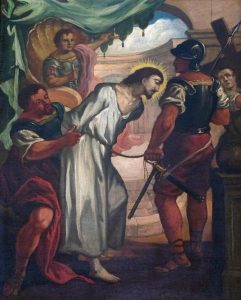Death entered into the world as a result of sin but through Christ, new life and a new beginning is granted. While fearing death is natural, the Christian can see death as a transition not a final chapter. It is a doorway to new life and the fullest life possible. It is not in the temporal world, where humanity’s nature is complete and unbroken, but only in the next life. In the next life, the soul is reunified with God and through the promised General Resurrection, the guarantee of unification of again and body and soul. Hence death is not an end but a phase of existence that is only temporary and an opening into a world so much larger. It thus extremely important to ensure that transition to the next life is a priority. This is the case for all world religions, but also the same for Christianity. With Heaven or Hell for eternity in the balance, ensuring a proper and good death with God is essential and vital.

Christianity has since its conception emphasized the importance of preparing for death. The Anointing of the Sick has its origins in Scripture. The Apostle James comments, “is any among you sick? Let him call for the elders of the Church, and let them pray over him, anointing him with oil in the name of the Lord; and the prayer of faith will save the sick man and the Lord will raise him up; and if he has committed sins, he will be forgiven (James 5:14-15).
Different Christian traditions all believe in the value of anointing in the sick and terminally ill, but others classify it differently. In Catholicism and Orthodoxy it is a sacrament. The Anglican Church considers it to have sacramental character and in most Lutheran and other Protestant denominations, see it as a critical ritual of the faith. As a sacrament, The Anointing of the Sick, and in the past, Extreme Unction, is an outward sign used to manifest and give grace to the soul. As a sacrament, it gives grace through the source of Christ’s death on the cross that flows through the Holy Spirit to the soul. It can be received multiple times depending on the grave danger of the person’s condition. Hence, it can be received in multiple terminal or possible death situations, whether in the hospital or home. In the Orthodox, it can also be utilized in communal services. In the West, under extraordinary circumstances, such as before war, soldiers and certain qualifying groups may receive it.
The matter, or visible sign, is the blessed holy oil. This oil in the West is blessed by diocesan bishop on Holy Thursday. In the East, this oil can be received throughout the year at the end of Liturgy on certain feast days but in itself is not the sacrament but used for overall physical and spiritual healing and continued good health. The form of the sacrament constitutes the various prayers and words offered by the priest or minister during the administration of the sacrament.

Last Rites is sometimes confused with Anointing of the Sick. It is important to note in Catholicism and Orthodoxy, Last Rites entails three sacraments. Anointing, confession and reception of the Eucharist.
The effects of the sacrament and ritual has multiple sacramental and grace infused benefits to the soul. It forgives sin but also prepares the soul to peacefully accept death and prepare it for reunion with God. Physically it can heal but healing and miracles are alone determined by the will of God. There are miraculous cases but these are extraordinary examples and not the norm. Death is natural and the healing is more so focused on the spiritual than physical. Although from a physical and psychological standpoint, the ritual can bring mental peace and a presence of God within the mind of the person. It is comforting to know that Christ is present with one in one’s suffering and death.
Throughout the study of suffering and Christian grief, the Christian does not seek to escape death, deny it, or even escape suffering, but is called to carry one’s cross and unify it with Christ as one’s High Priest. Christ is the ultimate example of the Suffering Servant and His example of accepting death and suffering should inspire other Christians to do the same. While always praying for a cure or miracle, the Christian should also be accepting of God’s will. One should primarily seek spiritual healing and God’s presence in one’s final moments.
During the reception of Anointing, one may be unconscious or awake, but it is critical to voice the need prior of the desire to receive it. Family or nurses should be made aware of one’s desire to see a minister or priest. This can be laid out in healthcare directives and becomes critically important if one becomes unconscious and unable to ask for spiritual aid in person. Also, it is important prior to risky surgery or potential unconsciousness due to drug induced states to request Anointing of the Sick. Most in everyday procedures that are not risky may simply say a short prayer of contrition and adoration before simple anesthesia but with far more risky procedure one should never leave one’s soul open to possible spiritual risk and danger.

In conclusion, spiritual preparation before death is critical. If it happens like a thief in the night, one may receive the sacrament post mortem but one should always pray both morning and night proclaiming love of God and sorrow for sins. One of the most beautiful things one can pray for is a peaceful death where one is able to receive the sacred mysteries in advance. This is a blessing that many sometimes never think of due to the fear of thinking about death itself. However, a peaceful Christian death with grace and the image of God is the greatest gift that may be given in this world.
Please also review AIHCP’s Christian Counseling Certification as well as its Christian Grief Counseling Program. Both programs are online and independent study and open to qualified professionals seeking a four year certification.
Additional Resources
“WHAT IS ANOINTING OF THE SICK? WHY IS IT IMPORTANT?”. Archdiocese of St Paul and Minneapolis. (2006). Access here
“The Anointing of the Sick – Catechism of the Catholic Church”. Catechism of the Catholic Church. CNA. Access here
“Is Anointing Oil Biblical and Should We Use It Today?”. Riggleman, H. (2021). Crosswalk. Access here
“40 Bible Verses about Anointing With Oil”. Knowing Jesus. Access here




